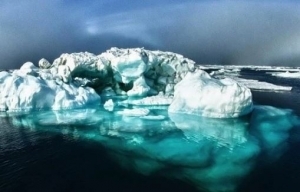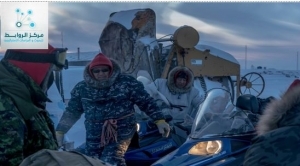Researcher Shatha Khalil *
Translated by : mudhaffar al-kusairi
Over the past three decades, global warming has contributed to the melting of the North Pole, whose temperature rises twice as fast as the rest of the world, although ecologists see that the world is heading towards a frightening climate change and this is a disaster, but five countries in the North Pole are looking at the issue differently that it will create a new economic zone that will change a lot.
These countries are the United States, Canada, Denmark, Norway and Russia, as they see it as an opportunity for new trade routes and potentially profitable offers in unexploited natural resources, in addition to shrinkage of 30 to 40% of the distance where ships sail between East Asia and northern Europe.
Russia has already installed more than a dozen seaports along the road in the northwest of the country in the northeast.
The area is: the northernmost point of the Earth’s axis, located about 725 kilometers north of Greenland.
Because of global warming, the Arctic has been melting at an alarming rate since the 1980s. This is worrisome – but for five countries in the Arctic they see great investment opportunities.
According to the Royal Institute of International Affairs, the Arctic could contain up to 90 billion barrels of oil and 47 trillion cubic meters of natural gas.
The US Geological Survey estimates that the Arctic holds 30% of the world’s undiscovered natural gas, and 13% of its oil.
In addition to the US Government Accountability Office’s estimates that about one trillion dollars in minerals such as gold, zinc, nickel, platinum, copper, titanium, graphite, uranium and other rare-earth elements that were difficult to reach, but 21 global warming make access to it closer and closer every year.
Under international law governed by the United Nations, it is possible for each country to claim up to 200 nautical miles (370 km) off its coast – what is known as the “exclusive economic zone”.
This means, everything is available to seize – provided that any country proves to the United Nations that its outer zone is its own, and Norway and Iceland are still the only two countries to have submitted claims agreed to by the United Nations.
But when country claims overlap, problems arise.
Russia, Denmark, and Canada have submitted overlapping claims awaiting approval.
Greenland, a Danish autonomous country, has the closest coast to the Arctic.
In 2014, Denmark claimed 895,000 square kilometers of land stretching from the Greenland border to the boundary of the 200-mile EEZ in Russia, and Russia remains unwilling to concede.
Which makes the emergence of a new competition for influence and control over the northern part of the world,
Russian endeavors: Since 2007, a polar mission led by Russia has raised the Russian flag in the Arctic, and Artur Chillingarov, one of the polar explorers, has declared that the Arctic is always for Russia.
The Kremlin is conducting military exercises and building bases in the Arctic, in an attempt to send a message to the rest of the world that it is ready to do everything necessary to control the region.

Russia has long sought economic and military control in the region where the volume of untapped oil and natural gas could reach $ 35 trillion.
Russia is the clear leader in infrastructure development in the Arctic, opening some deserted Soviet-era military installations and establishing new facilities and airports in its northern territories, with the construction of a series of seaports along its northern coast.
And the state-controlled oil company Rosneft began digging the northern bridge in the northern shelf of the Arctic last year in an attempt to take advantage of a field that could contain more than half a billion barrels of oil.
Then it found its first oil field, in the Sea of Laptev, in the east of the Arctic.
Meanwhile, Russian energy giant Gazprom Neft is already pumping oil from Arctic waters through a different offshore field, in the Pechora Sea.
In Russia there are approximately 40 service sweepers, with five other ships under construction and another planned six ones.
.The ultimate goal: to have offshore Arctic oil account for between 20 and 30 percent of Russian production by 2050
Obtaining marine oil in the Arctic represents between 20 and 30% of Russian production by 2050, which is the most important goal Russia seeks to reach ,according to the source below.
Russia is not alone interested in the arctic economy, as Finland, the United States, and Canada have proposed a major investment in infrastructure within their respective Arctic regions.
The state energy company is operating in Norway for exploration activities in remote areas of the Barents Sea.
It is worth noting the Russian efforts to build presence and influence in the upper north. Russia has more bases north of the Arctic Circle than all other countries all together, and it is building more distinguished military capabilities.
Finland, which has the second largest icebreaker fleet in the world, has seven times more, followed by Canada and Sweden six times, and the United States has five, and only one of them is called a heavy icebreaker, and the US Coast Guard, which is striving to modernize its aging fleet, to build six others (three heavy sweepers and three medium snow sweepers), although the first ship will not be delivered until 2023.
The Trump administration has also announced plans to open a large portion of the United States outer continental shelf to marine drilling operations, including areas located next to the northern coast of Alaska.
Arctic military exercises are aimed at confronting Russia, but the first task is the cold battle, as confirmed by writer Helen Cooper.
Military Drills in Arctic Aim to Counter Russia, but the First Mission Is the Cold Battle as confirmed By Helene Cooper.
Canada:
Richard Walker, a spokesman for global affairs in Canada, says the government “strongly confirms” its presence in the north to protect Canada’s arctic lands, and that it is cooperating with all Arctic Council members, including Russia, to advance common interests that include sustainable development and roles of Indigenous people , environmental protection and scientific research.
“Given the harsh environment and the high cost of Arctic operations, Canada believes that cooperation between the Arctic countries is necessary,” Walker wrote.
It is important for Canadians to be aware of the Arctic and what is happening in the North.
John Hegenbotham of the International Innovation Center for Governance in Waterloo said Canada only needed to keep pace with it because it could not rely on the existing international system to maintain it.
As for China: Although it does not have a regional claim in the Arctic, but as it is as a rising investment force that has the ability to compete for resources and influence in the region, with its increasing economic and maritime strength, as it began to secure Arctic development projects, which confirms the increasing global importance of the region , as China announced its ambitions to develop a “polar silk road” across the region, as warm global temperatures open on new sea lines and economic opportunities at the top of the world.
The Belt and Road Initiative is a $ 1 trillion project that seeks to link countries across continents with trade, with China at its center.
Earlier this year, he explained in detail the plans of the North Sea route.
He said: China is an active participant and contributor to Arctic affairs and has spared no effort to contribute its wisdom to the development of the Arctic.
Ultimately, Beijing wants to take advantage of the open sea route as a shortcut to trade with Europe, which will reduce the travel times and costs.
“Although all infrastructure projects in the Arctic region recorded by Guggenheim will not be completed, however, the level of projects is improving” says Jim Pace, senior manager of Guggenheim Partners, which specializes in north projects that has traveled extensively in the Arctic region. .
He says: The projects that were once considered largely conceptual, have matured into thoughtful capital infrastructure projects that show a tangible return on investment, while the ice continues to recede, the race is competing to develop or buy projects that can position the best countries and companies to compete in the new Arctic.
Among the possible investments, confirmed by data on new oil, the new Arctic may also be home to these pipelines, and marine cables placed across the Arctic can one day connect Asia, North Europe, and North America directly, providing much shorter routes for data to travel around Northern Hemisphere.
“Whether it is a fraction of a millisecond required for financial transactions to travel between Tokyo and London, or whether shorter shipping routes from northern Europe to China, the North Pole cuts distances , with continuing of Globalization in emphasizing on speed , the Arctic will remain an important part of the global economy ” , says Heather Conley, Senior Vice President, Europe, and Asia.
In conclusion, despite the decline in ice, the story of the new Arctic remains slow to develop, and the Arctic remains a difficult environment to work in.
Sources:
https://www.cnbc.com/2018/02/06/russia-and-china-battle-us-in-race-to-control-arctic.htmlhttps://globalnews.ca/news/4945298/russia-north-pole-canadahttps://www.nytimes.com/2019/04/12/world/europe/global-warming-russia-arctic-usa.htmlhttps://www.vice.com/en_ca/article/bn5n33/russia-is-trying-to-bully-their-way-past-canada-into-arctic-so.
Economic Studies Unit
Rawabet Center for Research and Strategic Studies

